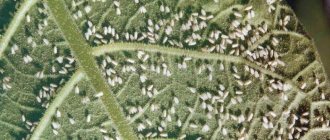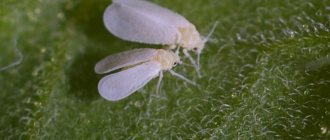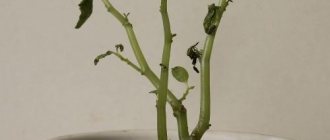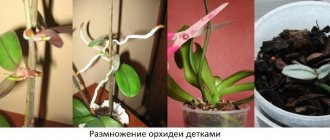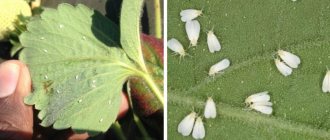A small white fly, which is very difficult to notice in the green foliage, is one of the most dangerous pests of flower and vegetable crops. It causes significant damage to them, quickly destroying indoor flowers or seedlings. The moth feels especially good in a greenhouse, where almost ideal conditions are created for it. Let's figure out how to get rid of whiteflies once and for all.
What does a whitefly look like?
The whitefly, or aleurodida, is a flying insect from the family of small Homoptera. In total, there are about 1,500 species of this insect in nature, and in our latitudes only 20 of its varieties can be found.
The whitefly is somewhat reminiscent of a moth or moth with its wings folded in the shape of a house. Its size does not exceed 3 millimeters in length. The insect is completely white with a small yellow head. The wings are covered with fine white pollen.
Types of flower midges
Before you start fighting midges in flowers, you need to know what pests there are. Let's take a quick look at the types of midges.
Fools
– the most frequent guests of indoor plants. Small, white midges no larger than 1 mm in size. They can be seen on the surface of freshly watered soil or at the foot of a flower pot.
Poduras appear mainly in the cool season, actively flying from leaf to leaf. The larvae of these pests, while in the ground, have a negative effect on the root system of the plant.
Sciarides
- small, black insects similar to mosquitoes. They fly abundantly throughout the living space.
The larvae of this pest are translucent worms up to 0.5 cm long. They make the soil dense, inaccessible to life-giving oxygen, and also attack the root of the plant itself.
Sciarides can appear as a result of the use of homemade organic fertilizers to feed plants (tea leaves, humus, sphagnum moss, rotting leaves).
Drosophila
– red, small midges, very similar to flies, can cause irreparable harm to our pet.
How to detect whitefly
Before you think about how to get rid of this pest, you need to figure out how to detect it. After all, the sooner you notice traces of the appearance of whiteflies, the fewer consequences you can deal with.
Most often, whiteflies can be detected by the following signs:
- the plant has sharply slowed down its growth and development, the leaves turn yellow and curl
- white spots appeared on the leaves, which over time changed their color to dark - this is a fungal disease that often infects the plant with whitefly
- the inside of the plate is covered with a sticky coating
- the inner side is covered with small transparent scales, the remains of cocoons or insect eggs
If there is no visible damage, but neighboring plants are already affected, take a simple pencil and lightly hit each leaf. If the whitefly has already infested the plants, after such shocks you will see tiny white insects falling from the leaves on the ground.
Harm from parasites
Damage is caused by all stages of butterfly development, except eggs . The larva feeds on plant sap, weakening them. Such flowers stop developing and begin to wither and dry out.
Adults do not feed on sap, but they pollute plants with their excrement, which are subsequently attacked by sooty fungus.
It causes the affected parts to turn black and rot. In addition, whiteflies carry dangerous viruses that cannot be treated. First of all, these are chlorosis , viral mosaics , jaundice and leaf curl .
ATTENTION! Sick plants infected with viruses are the easiest to dispose of.
Where does the whitefly come from?
Whitefly can attack a plant in open ground, in a greenhouse, and even indoors. Even if the appearance of this insect in these specific conditions seems impossible, the whitefly can always find its way to the plant through:
- Soil. Most often, there are already eggs of this pest in the garden soil, and by placing the plant in greenhouse or indoor conditions, you can speed up the process of the appearance of the pest
- Window. Even mosquito nets will not stop the whitefly; its size allows it to climb into any hole
- Infected sprout. Cuttings shared by gardeners may already be infested with whitefly larvae.
The insect loves hot rooms where there is no good ventilation.
Whitefly eggs can wait a long time until the temperature and conditions they need are established, and only then turn into insects. At the same time, the whitefly cannot tolerate the cold and dies at temperatures below 10 degrees Celsius.
Features of biological protection
When we fight pests using chemicals, we have to be extremely careful! Inept handling of drugs leads to various consequences. Moreover, not only plants are at risk; the gardener himself is also at risk in a certain sense.
The use of biomaterial is a more gentle solution and an alternative to chemistry. The essence of the biological technique is to intentionally introduce other insects to the garden crop, which will be beneficial by eating whitefly larvae. At the same time, the plants themselves remain safe and sound. Among such saviors we can note the two most common enemies of whiteflies:
- predatory bug Macrolophus;
- parasite of the greenhouse whitefly Encarzia.
Having completed the “cleansing”, the saviors leave the “processing” zone and move to another place. To purchase such biological material, you should contact any large garden farm or laboratory.
The Macrolophus bug is considered a true whitefly killer
Prevention measures
It is easier to prevent the appearance of whiteflies than to later look for means to combat this pest. To avoid this threat, you must:
- fertilize the plant during planting and during growth and flowering
- do not plant plants close to each other
- do not fertilize the plant in the cold season
- monitor indoor air humidity
- provide fresh air access to the room, ventilate it
If, despite proper care of the plants, the pest still appears, it is necessary to select the optimal remedy for whiteflies.
Why white midge appears on tomatoes and how to get rid of it
Whiteflies often attack tomatoes grown in greenhouses or greenhouses. Insects appear when it rains frequently. The moth looks like an ordinary midge, only white. The pest most often appears in mid-summer under favorable conditions - high humidity and high air temperatures.
A gardener may not immediately recognize that pests have appeared on his site - whiteflies choose to live on the lower leaves of a plant or hide on their insides.
You can save the entire crop from white midges if there are only moths on the plants without larvae. The fight against small pests needs to be approached comprehensively.
The most common ways are:
- fumigation;
- chemical treatment;
- biological drugs;
- bait.
Chemicals against whiteflies
When choosing effective pest control products, you need to pay attention to the safety of use in enclosed spaces. For example, insecticides are considered the most effective, but when treating plants, you cannot stay indoors for a long time.
The most common means are:
- Mospilan. Single spraying 0.05-0.06 g
- Actellik. One ampoule per liter of water to treat 5 square meters
- Confidor. 0.1 ml per liter of water and spray once
- Fufanon. 1.5 ml - one-time spraying
Rules for processing plants
In order to ruthlessly destroy whiteflies on strawberries by using chemicals, you must adhere to certain rules:
- Strictly follow the dosage prescribed by the manufacturers in the instructions!
- Spraying the crop should be carried out only in dry and windless weather!
- Use different preparations each time so that insects cannot get used to them!
- The process of treating plants should be carried out in the early morning hours or in the evening at sunset! The sun's rays coming into contact with drops containing toxic substances can cause burns.
- With frequent and incorrect use of chemicals, their substances accumulate in the soil. Eating berries collected from cultivated areas is unsafe!
For your information! The pest leaves behind transparent tracks on the back of the leaves, which make it easy to detect. Whiteflies can also be seen upon careful inspection.
You can significantly reduce the population of adult whiteflies and their larvae in your garden in 4 procedures, taking a break of 5 days. Only with each subsequent treatment should the concentration of the drug be reduced. Only compliance with these conditions will allow you to completely get rid of pests and keep the delicacy safe for consumption.
Mechanical action against whitefly
If treatment for whiteflies with chemicals is successful, then the effect can be enhanced by mechanical means. For example, the following are effective:
- fumigators against flies and mosquitoes placed at the base of the damaged plant
- handmade traps: small pieces of plywood painted with oil paint or wrapped with double-sided tape
Once the chemical attack has been applied, such methods can help eliminate any remaining insects.
Soap
It is best to use tar or special green soap, but the simplest laundry soap will do. A soapy film covering the leaves and stems prevents pests from feeding normally. If the solution of fatty acids comes into direct contact with the body of an insect, it has a detrimental effect on its body.
You need to do this:
- Grind 100 g of soap on a fine grater.
- Pour in a small amount of water.
- Let it brew for 2-3 hours.
- When the soap turns into a slippery and viscous mass, increase the volume of the solution to 0.5 liters.
- Spray the affected flowers and spill the soil in the containers.
- Repeat treatment for two weeks every 2-3 days.
Traditional methods of dealing with whitefly
The fight against whiteflies has been carried out by gardeners and flower growers for a very long time. Over the years, many effective recipes have appeared among the people that help get rid of this pest. The most popular of them:
Soap solution
Grate laundry soap or cut into thin shavings and dissolve in warm water in a ratio of 1:6. Apply foam from this solution to the plant and the top of the soil. Often one application is enough to ensure that the pest no longer exists. But if necessary, the procedure can be repeated after a week.
Dandelion infusion
100 grams of dandelions (with leaves and roots) are infused in a liter of water for several days. The solution must be filtered and sprayed on the plants with a spray bottle.
Tobacco infusion
All cigarettes from the pack are opened and filled with water for several days. The solution must be filtered and the plants sprayed with it from a spray bottle every few days.
Garlic infusion
Chop a few cloves, add 1 liter of water and leave for a day. Strain the solution and spray the plant with it from a spray bottle several times at intervals a week.
Yarrow infusion
Pour 100 g of yarrow into 1 liter of water and leave for several days. Strain the solution and spray the plant with it from a spray bottle several times at intervals a week.
It is known that the whitefly cannot tolerate low temperatures. Therefore, another popular method can be considered placing plants in a place where the air temperature does not currently exceed 10 degrees.
However, when using this method, it is necessary to take into account the susceptibility of the plant itself to low temperatures.
Photos of whiteflies may seem harmless, but the first impression in this case will be wrong. The damage this insect can cause is colossal. Therefore, it is necessary to detect the pest in time and quickly neutralize it.
Preventive actions
No wonder there is a popular wisdom: the best defense is an attack. Therefore, any lover of garden crops interested in growing strawberries and other berries needs to prepare in advance for the upcoming attack from natural profit lovers.
It is optimal to place onion or garlic plantings between the rows - they emit a pungent and unpleasant odor for insects, which will avoid this place. True aesthetes should take a closer look at marigolds and nasturtiums. Small parasites also cannot stand the smell of these flowers.
Important! Since the damage from the miniature pest is very great, it is necessary to carefully inspect the young bush before planting it for the presence of uninvited guests. The main reason for the mass death of plantings is the acquisition of an infected seedling/
A similar effect can be achieved by using wood ash. To repel pests, you should scatter it near the bushes. In addition, it is useful to give the culture a hot shower every month. The water is heated to 80 °C, and the plants are watered from a watering can.
Whitefly photo
Matches
The sulfur found on match heads forms toxic compounds when interacting with water. They have a detrimental effect not only on pathogens of fungal diseases, but also on herbivorous insects. Sulfur fumes kill midges.
Step-by-step instructions for use:
- Stick 10-15 matches, heads down, along the edge of the pot.
- Water the ground.
- When the sulfur dissolves and the matches become “naked”, replace them with new ones.
- Do this several times.
Citrus
Strong citrus scents irritate flying pests. Essential oils of orange, lemon, and tangerine effectively repel. They do not cause direct harm to midges, but at the same time they do not allow them to settle on other, not yet infected indoor plants.
Step-by-step instruction:
- Remove the peel from 2-3 citrus fruits.
- Pour boiling water (1 l).
- Leave for 4-5 hours.
- Spray the citrus infusion generously on all the indoor flowers in the house.
- Repeat at least 5-6 times, at intervals of 2-3 days.
- You can simply spread fresh peels in flower pots, digging them a little into the substrate.
Ash
Wood ash is widely used in gardening to combat harmful insects. Fine ash powder, getting into the respiratory tract of midges or on the outer integument of the larvae, corrodes them, since it is an alkali (albeit a rather weak one).
Method of use:
- Sift wood ash through a sieve.
- Stop watering flowers.
- Distribute the ash over the entire surface of the soil in the pot in an even layer at least 5-6 mm thick.
- Sprinkle the entire plant with fine ash powder.
- The course of “treatment” should last at least two weeks.
Ash is an excellent organic fertilizer rich in potassium. This element has a positive effect on the process of flower bud formation.
Fumigators
Special anti-mosquito devices - electric fumigators exterminate midges in the same way as all other flying insects. When the active component of the device is heated, it releases toxic substances that kill pests.
Instructions for use:
- Buy a fumigator at the store.
- Insert a working scent pad or bottle of liquid.
- Connect the device to the mains for 3-4 hours.
- Then turn it on daily for 2 weeks.
Life activity
When the owners know the peculiarities of the lifestyle and behavior of the fleurs, then it will be easier for them to protect their homes from their invasion. This will also help gardeners, on the contrary, create favorable conditions for their cultivation. Thus, the common lacewing has unique behavioral characteristics. Here are some of them:
- Maximum activity of adults is in the evening;
- does not tolerate prolonged exposure to direct sunlight;
- settles in shady and damp places: under leaves or in the grass;
- midges begin to crawl out of their shelters in spring at temperatures above 10°C;
- they flock to the bright light of electric lamps, thereby penetrating the house;
- lay several dozen eggs (on long threads) near aphid colonies.
The larvae spend the winter in attics, in cracks in houses or under the bark of trees. If the owners want to get rid of them, then efforts must be made to get them out of there.
These “defenders” can be found in a personal plot or vegetable garden. Those who work in greenhouses should also be attentive to the appearance of flannel plants. Still, experts even recommend adding these “orderlies” to your garden, orchard or greenhouse. They will help get rid of dozens of pests.
Diet
In nature, there are two types of midges: predators and non-predatory individuals. The latter feed exclusively on non-living organisms: aphid secretions, pollen or flower nectar. When asked whether the lacewing is a pest or a protector, the answer can be unequivocal that it works for the benefit of gardeners. Its larvae eat over 80 varieties of pests, such as:
- caterpillars;
- spider and other types of mites;
- shield insects;
- aphids and their larvae;
- moths;
- Colorado potato beetle eggs;
- leafhoppers;
- wood borers;
- mole;
- Poisonous spider cocoons.
The midge feeds only on soft-bodied insects. Over the course of 7 days, each individual destroys up to 200 units of aphids, insects or eggs. Females produce between 200 and 400 eggs in their lifetime.
https://www.youtube.com/watch?v=ZgTsnWRDGWc
Aerosols
Insecticidal aerosols used against flying pests are also guaranteed to quickly exterminate annoying flower midges. However, pesticides sprayed into the air kill only adult individuals upon direct contact.
Procedure:
- Take an insecticidal aerosol (Raptor, Dichlorvos, Komaroff, Deta, etc.).
- Spray the contents of the can around the plant, on the soil in the pot, on the windowsill, according to the instructions for use.
- Treat the walls of the pot and the tray.
- After an hour, ventilate the room well, covering the flower from drafts, and carry out wet cleaning.
Duct tape
It is quite possible to catch midges mechanically. Stores sell special sticky tapes or traps for flying insects (often they simply write - for flies, this is suitable). This method works well when the pest population is not too large.
Procedure:
- Unfold the adhesive tape.
- Hang near the plant.
- Do not remove the traps until the flying individuals disappear completely.
It is especially effective at night to keep a light on with adhesive tapes hanging on it. Because light attracts midges.
If you have the desire, dexterity and ability, you can make adhesive tape at home using improvised materials.
Drying
Midges can lay eggs and reproduce only in damp conditions. In dry soil, the larvae cannot develop normally and die. In some cases, you can simply deprive them of a favorable habitat. But this is not applicable to all flower crops.
The technology is like this:
- Stop watering the plant.
- When the earthen ball is completely dry, pour a layer of calcined sand on top.
- Sprinkle with a very weak pinkish solution of potassium permanganate.
- Repeat in a month if the midges appear again.
IMPORTANT: suitable for plants that normally tolerate drought.
Cold
Midges are extremely thermophilic. As the ambient temperature drops, they gradually become less active and then die. Cold quarantine, when it is cool outside, will help those plants (for example, fuchsia, geranium, camellia, cactus) that are able to withstand a prolonged drop in temperature to at least +10 °C without loss.
The technology is like this:
- Place the flowers on the balcony, loggia, garden, etc. (depending on the climate, time of year, warmth in the room and the plant).
- Keep the plants in the cold for at least a week.
- Bring it into the house for 2-3 weeks.
- Again, take it out into the cold so that the midges that hatch from the eggs later die.
- Repeat the procedure 2-3 times.
Of course, the method is suitable for the time of year when it is cool or cold outside.
Substrate replacement
A complete replacement of the soil will radically solve the problem of the presence of midges in indoor flowers. Indeed, in most cases, insects lay eggs in the ground, where larvae develop from them. The method is appropriate in the spring-summer period (growing season).
You need to do this:
- Remove the flower from the pot.
- Shake off any remaining soil from the roots.
- Rinse them with water (important: not all plants like this and are okay with this; there are exceptions).
- Soak for 15-20 minutes in an insecticide solution (Aktara, Actellik, etc.) prepared according to the instructions for the specific product.
- Wash the planting container with soap and disinfect it (scald with boiling water, rinse with a solution of potassium permanganate, etc.).
- Plant the plant in a fresh and clean substrate.
To eliminate the very possibility of midges appearing in the house, it is recommended to pre-etch the planting soil (steam in a water bath, in extreme cases, fry in the oven, etc.).
Geological history
Lacewings have been known since the time of dinosaurs. The oldest were found in Jurassic deposits near the village of Daohugou (Ningcheng County, Inner Mongolia, China), they are 165 million years old. In the Upper Jurassic and Lower Cretaceous there were already a lot of them, in other places their fossilized traces made up about a third of the traces of lacewings; most of the lacewings were then from the genus Mesypochrysa, which is part of the extinct subfamily Limaiinae. In the early Eocene, Limaiinae disappear, presumably due to a lack of camouflage in the face of increased numbers of ants, which protected aphids from lacewings and destroyed the latter. Limaiinae is replaced by the subfamily Nothochrysinae, which dominated until the beginning of the Miocene; their numbers decreased presumably due to the lack of an organ that responds to ultrasound, with the help of which bats began to hunt lacewings for some time. Modern lacewings from the subfamily Nothochrysinae make up 3 percent of all lacewings, the rest belong to the subfamilies Chrysopinae and Apochrysinae, members of which have an organ that detects ultrasound.
Ammonia
Insects cannot tolerate the pungent ammonia aroma and strive to move away from its source as quickly as possible. In addition, ammonia solution is considered an excellent nitrogen fertilizer, which simultaneously kills larvae and eggs in the ground.
Mode of application:
- Dilute 25 ml of ammonia in 2 liters of water.
- Treat the above-ground part with a sprayer.
- Water the soil.
- Repeat spraying and watering weekly for a month.
Bonus: nitrogen fertilizing of plants.
Read: 18 ways to use ammonia in the garden and garden at the dacha
Reproduction
After the lacewing has had enough, it begins laying eggs. Method of laying eggs
These insects have a very interesting look. Having chosen a suitable leaf, the female lacewing releases a sticky drop from her abdomen onto its surface. This drop, rising in the air, is pulled into a thin thread 10–14 mm long. The thread of the adhesive mass immediately hardens. The female attaches an oblong-shaped egg to the upper end of the thread. And this is how she lays all her eggs. In one day, their number reaches 60. Over the course of its entire life, the lacewing lays up to 400 eggs.
This cunning method is justified by the desire of the lacewing to prevent the first hatched larva from eating the eggs. That's why she places it higher. Otherwise, instead of 60 larvae, only 6–12 will be born and survive.
The lacewing takes care of the nutrition of its offspring in advance, choosing a leaf with a dense accumulation of aphids.
After a few days, reddish and brown larvae hatch from the laid eggs, the length of which is about 7 mm. Immediately after birth, the larva molts and goes hunting. The jaws are sharp, curved in the shape of a sickle. The larvae have 3 pairs of legs, of which the thoracic legs are the most developed. Some larvae cover their bodies with skins of dead aphids and look like small lumps of garbage.
Lacewing larvae, like adult insects, are very voracious. With their sharp jaws, they greedily grab the victim and inject poison into it, causing paralysis. The venom is injected using tubular mandibles similar to syringe needles. The lacewing stays in the larval phase for 2 weeks, during which it eats about 400. Then comes the pupal phase, lasting 5 days.
Characteristics of the pest
Many plant growers are interested in: how to deal with malicious garden pests such as whiteflies? It often settles in greenhouses, greenhouses, less often in the open air or indoor plants, actively reproduces, and can seriously damage the crop, even to the point of its complete destruction, if measures are not taken in time. Whitefly, also known as aleurodidae, is a very common pest that occurs in greenhouses. Aleron means flour in Greek.
The parasite is an insect capable of flight, vaguely resembling a white moth with a body length of less than 0.2-0.3 cm. It settles in large colonies, damaging more than 600 species of cultivated and weed plants, preferring the youngest, succulent leaves. Thanks to elastic wings covered with a waxy coating, the creature is reliably protected from the influence of the vast majority of insecticides. Its larvae look like grayish grains.
In the natural environment, the whitefly feeds on a variety of flowers, but it really likes cucumbers, tomatoes, eggplants, and peppers in greenhouses. Hundreds, thousands of pests can quickly destroy almost the entire crop in greenhouses of any size. The insect does not reveal itself for a long time, hiding under the crown of the plant.
For its nutrition, the creature uses not specifically the leaves, but the juice that is inside them. As a result of such exposure, the plant quickly loses strength, new shoots stop appearing, individual parts wither, the stem dries out, becomes brittle, which leads to death. The insect sucks out a huge amount of liquid, releasing most of it directly onto the plantings, which is why they become covered with a sticky coating, which favors the appearance of various forms of fungus, almost completely blocking the ability to photosynthesis.
The most dangerous species
Aleurodids are a family of 1,500 insect species, about 20 of which are dangerous to crops. The most common is the greenhouse or greenhouse type, once imported from South America. In mid-latitudes, the pest is able to survive year-round. Not only does he fly well, but he also runs fast on 6 long legs. Belongs to Hemiptera.
Southern regions are often attacked by tobacco whitefly. It is distinguished by the fact that the wings are folded on the sides, rather than in the shape of a roof. Control of various pests may differ slightly in all respects. Cotton or tobacco produces 20-25 generations per year, but actively develops only at a temperature of +32-36 degrees.
Acid aleurodide is often brought from China along with citrus seedlings. This is a quarantine insect that is not able to survive in temperate climates, but is dangerous in warm regions. Strawberry and cabbage varieties are also often found. They produce no more than 1 generation per season, the damage from them is insignificant, unlike those species that feed on any weeds.
Most of them bury themselves in the ground for the winter, in compost heaps, where they wait for favorable conditions to procreate. Among other things, the pest spreads many diseases:
- virus of tomato leaf curl and tobacco plants - they become yellow and sharply deformed;
- golden mosaic;
- infectious yellowing of cucumbers and certain types of lettuce.
Life cycle of an insect pest
Aleurodida reproduces excessively quickly. It is almost impossible to control the population that has settled in a greenhouse. The parasite lays eggs on the inside of the leaf - there they are hardly noticeable, and their removal is problematic. The hatched larvae look for their own food. If you do not destroy them at this stage, then, having matured and already flying, the whiteflies move to other plants, gradually infecting them all.
The life cycle of a moth is quite complex:
- laying eggs - the female gives 120-250 eggs during one period, 15-20 at a time. She lives for about a month;
- first instar larvae hatch in 12-13 days. They are called “strays” because they quickly spread throughout the plant;
- larvae of the second instar - stick to the most juicy parts, being motionless and covered with a waxy coating;
- larvae of 3-4 instars – full-fledged insects emerge;
- adult individuals have the ability to fly and actively eat available vegetables.
In comfortable conditions, all stages are mastered in 25-45 days - if the environment is warm and humid enough. Fertility directly depends on the plant-breadwinner - the juicier it is, the more rapidly the parasite multiplies. Its maximum abundance is observed in July-August, especially if there are frequent warm rains.
What you need to know about whitefly infestation?
It is not difficult to determine that vegetables are affected by this particular insect - the “traces” of pests resemble an invasion of aphids. The leaves quickly become sticky, curl, and are covered with yellow-brownish spots. If you touch the plant, a flock of white, very small butterflies takes off from it and flutters from place to place. When this is noticed, all vegetation in the greenhouse should be carefully examined to identify signs of damage:
- vegetable crops are greatly retarded in growth;
- the leaves have yellow fuzzy spots, some are deformed, some are already withering;
- the whole plant is covered with a honey-like sticky layer;
- there are areas of black color - sooty fungus that accompanies dew;
- the lower part of the leaves is partially covered with translucent scales - these are aleurodid larvae. When at least one symptom is present - the entire crop in the greenhouse is under threat of destruction, in order to save it, some criteria must be urgently adopted.
Why does this parasite appear?
There are many reasons why this creature gets wound up. For example, when the summer is rainy but warm, the pest loves high humidity and temperature, so it often settles in greenhouses. He will like those greenhouses where vegetables and flowers grow too close to each other, while there is practically no sufficient ventilation.
It is advisable to begin the fight against harmful insects as early as possible - long before harvest:
- plantings are planted at a great distance from each other;
- high-quality, frequent ventilation is organized;
- fertilized with effective biostimulants;
- do not spray if humidity is high.
Preparations such as Domotsvet, Epin, Amulet, etc. will be useful as feeding.
